
ColecoVision is a second-generation home video-game console developed by Coleco and launched in North America in August 1982. It was released a year later in Europe by CBS Electronics as the CBS ColecoVision.

Zaxxon is an isometric shooter arcade video game, developed and released by Sega in 1982. The player pilots a ship through heavily defended space fortresses. Japanese electronics company Ikegami Tsushinki also developed the game.
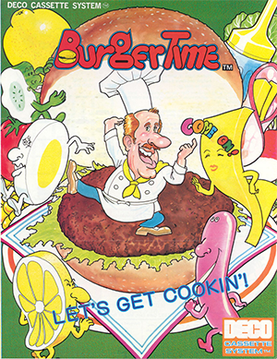
BurgerTime, originally released as Hamburger in Japan, is a 1982 arcade video game from Data East released initially for its DECO Cassette System. The player is chef Peter Pepper, who must walk over hamburger ingredients in a maze of platforms and ladders while avoiding anthropomorphic hot dogs, fried eggs, and pickles which are in pursuit.

Breakout is an arcade video game developed and published by Atari, Inc. and released on May 13, 1976. It was designed by Steve Wozniak, based on conceptualization from Nolan Bushnell and Steve Bristow, who were influenced by the seminal 1972 Atari arcade game Pong. In Breakout, a layer of bricks lines the top third of the screen and the goal is to destroy them all by repeatedly bouncing a ball off a paddle into them. The arcade game was released in Japan by Namco. Breakout was a worldwide commercial success, among the top five highest-grossing arcade video games of 1976 in both the United States and Japan and then among the top three highest-grossing arcade video games of 1977 in the US and Japan. The 1978 Atari VCS port uses color graphics instead of a monochrome screen with colored overlay.
1983 has seen many sequels and prequels in video games, such as Mario Bros. and Pole Position II, along with new titles such as Astron Belt, Champion Baseball, Dragon's Lair, Elevator Action, Spy Hunter and Track & Field. Major events include the video game crash of 1983 in North America, and the third generation of video game consoles beginning with the launch of Nintendo's Family Computer (Famicom) and Sega's SG-1000 in Japan. The year's highest-grossing video game was Namco's arcade game Pole Position, while the year's best-selling home system was Nintendo's Game & Watch for the third time since 1980.
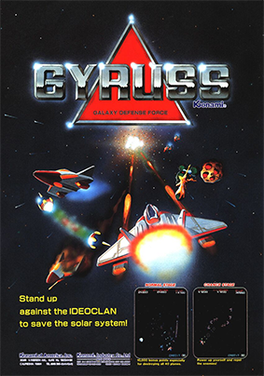
Gyruss is shoot 'em up arcade video game designed by Yoshiki Okamoto and released by Konami in 1983. Gyruss was initially licensed to Centuri in the United States for dedicated machines, before Konami released their own self-distributed conversion kits for the game. Parker Brothers released contemporary ports for home systems. An enhanced version for the Family Computer Disk System was released in 1988, which was released to the North American Nintendo Entertainment System in early 1989.

Choplifter is a military themed scrolling shooter developed by Dan Gorlin for the Apple II and published by Broderbund in 1982. It was ported to the Atari 8-bit family the same year and also to the VIC-20, Commodore 64, Atari 5200, ColecoVision, MSX, and Thomson computers.
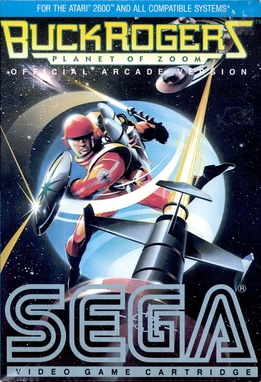
Buck Rogers: Planet of Zoom, known as Zoom 909 in Japan, is a pseudo-3D rail shooter released as an arcade video game by Sega in 1982. The player controls a spaceship in a third-person perspective, adapting the three-dimensional perspective of Sega's earlier racing game Turbo (1981) for the space shoot 'em up genre. It used the Buck Rogers license, referencing the space battles, though Buck himself is never seen.

Jungle King, re-released as Jungle Hunt, is a side-scrolling action game developed by Taito and released for arcades in 1982. It was originally distributed as Jungle King, then quickly modified and re-released as Jungle Hunt due to a copyright dispute over the player character's likeness to Tarzan. Jungle King, along with Moon Patrol released a month earlier, is one of the first video games with parallax scrolling.

Universal Entertainment Corporation, formerly known as Aruze Corporation and Universal, is a Japanese manufacturer of pachinko, slot machines, arcade games and other gaming products, and a publisher of video games. Aruze possesses licenses to both manufacture and distribute casino machines in the American states of Nevada, Mississippi and New Jersey. The company's corporate headquarters are in Tokyo. Aruze is also the licence holder of the video game franchise Shadow Hearts. Up until February 18, 2012, the company owned approximately 21% of Wynn Resorts. On November 1, 2009, Aruze Corporation changed its name to Universal Entertainment Corporation due to financial difficulties.

Star Wars is a first-person rail shooter designed by Mike Hally and released as an arcade video game in 1983 by Atari, Inc. It uses 3D color vector graphics to simulate the assault on the Death Star from the 1977 film Star Wars. There are three connected gameplay sequences: combat against TIE fighters in space, flying across the surface of the Death Star, and the final trench run. The sequence repeats with added complications and the Death Star regenerating for each. The player's X-Wing fighter has a shield which only protects against damage a certain number of times, then the next hit ends the game. Speech synthesis emulates actors from the film.
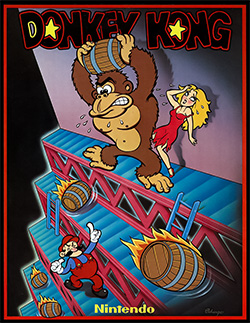
Donkey Kong is a 1981 arcade video game developed and published by Nintendo. As Mario, the player runs and jumps on platforms and climbs ladders to ascend a construction site and rescue Pauline from a giant gorilla, Donkey Kong. It is the first game in the Donkey Kong series as well as Mario's first appearance in a video game.
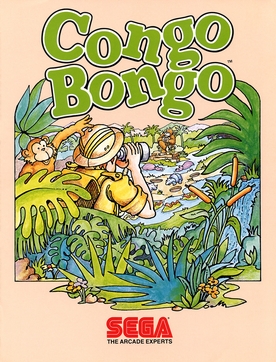
Congo Bongo, also known as Tip Top, is a platform game released as an arcade video game by Sega in 1983. A message in the ROM indicates it was coded at least in part by the company Ikegami Tsushinki. The game is viewed in an isometric perspective, like Sega's earlier Zaxxon (1982), but does not scroll. Numerous home ports followed.
1982 was the peak year for the golden age of arcade video games as well as the second generation of video game consoles. Many games were released that would spawn franchises, or at least sequels, including Dig Dug, Pole Position, Mr. Do!, Zaxxon, Q*bert, Time Pilot and Pitfall! The year's highest-grossing video game was Namco's arcade game Pac-Man, for the third year in a row, while the year's best-selling home system was the Atari 2600. Additional video game consoles added to a crowded market, notably the ColecoVision and Atari 5200. Troubles at Atari late in the year triggered the video game crash of 1983.

Mr. Do's Castle is a platform game released in arcades by Universal in September 1983. In Japan, the game is titled Mr. Do! versus Unicorns. Marketed as a sequel to the original Mr. Do! released one year earlier, the game bears a far closer resemblance to Universal's Space Panic from 1980. It began as a game called Knights vs. Unicorns, but the U.S. division of Universal persuaded the Japanese arm to modify the graphics into a Mr. Do! game following the first game's popularity.

Space Panic is a 1980 arcade video game developed by Universal. Predating Nintendo's Donkey Kong, and lacking a jump mechanic, Space Panic was the first game involving climbing ladders between walkable platforms. The genre was initially labeled "climbing games", but later became known as platform games. A ColecoVision port by CBS Electronics was released in the winter holiday season of 1982.
In video gaming parlance, a conversion is the production of a game on one computer or console that was originally written for another system. Over the years, video game conversion has taken form in a number of different ways, both in their style and the method in which they were converted.
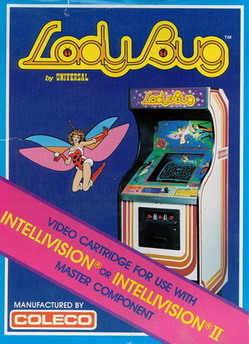
Lady Bug is a maze chase video game produced by Universal and released for arcades in 1981. Its gameplay is similar to Pac-Man, with the primary addition to the formula being gates that change the layout of the maze when used, adding an element of strategy to the genre. The arcade original was relatively obscure, but the game found wider recognition and success as a launch title for the ColecoVision console.

Looping is an action game developed and published in arcades in 1982 by Video Games GmbH in Europe and Venture Line in North America. The player controls a plane across two phases in order to reach a docking station by destroying a terminal base or a rocket base to open a gate while avoiding obstacles along the way.

















